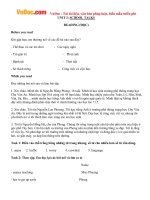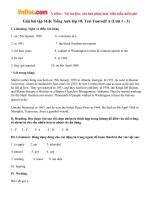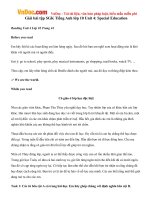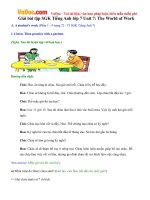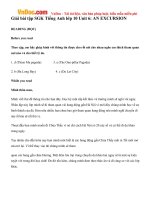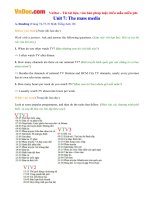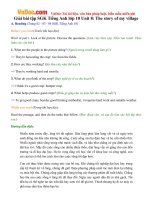Giải bài tập SGK Tiếng Anh lớp 10 Unit 9: Undersea World
Bạn đang xem bản rút gọn của tài liệu. Xem và tải ngay bản đầy đủ của tài liệu tại đây (330.49 KB, 9 trang )
VnDoc - Tải tài liệu, văn bản pháp luật, biểu mẫu miễn phí
Giải bài tập SGK Tiếng Anh lớp 10 Unit 9: Undersea World
A. Reading (Trang 94-95-96 SGK Tiếng Anh 10)
Before you read (Trước khi bạn đọc)
- Work with a partner. Look at the map and give the Vietnamese names for the oceans on the map.
(Làm việc với bạn học. Nhìn vào bản đồ và viết tên các đại dương trên bản đồ bằng tiếng Việt.)
Antarctic Ocean: Nam Băng Dương
Arctic Ocean: Bắc Băng Dương
Atlantic Ocean: Đại Tây Dương
Indian Ocean: Ấn Độ Dương
Pacific Ocean: Thái Bình Dương
- Work with a partner. Look at the pictures below. Can you name the sea animal in each picture? The
first letter of the word has been given to help you. (Làm việc với bạn học. Bạn có thể gọi tên các động
vật biển trong mỗi bức tranh? Chữ cái đầu tiên của từ đã được cho sẵn giúp bạn.)
Seal: hải cẩu
Jellyfish: con sứa
Turtle: rùa biển
Shark: cá mập
While you read (Trong khi bạn đọc)
Read the text and do the tasks that follow. (Đọc đoạn văn và làm các bài tập theo sau.)
Hướng dẫn dịch:
VnDoc - Tải tài liệu, văn bản pháp luật, biểu mẫu miễn phí
Chỉ có một đại dương duy nhất. Nó được chia thành năm phần khác nhau: Thái Bình
Dương, Đại Tây Dương, Ấn Độ Dương, Nam Băng Dương và Bắc Băng Dương. Cũng
còn có nhiều biển, vùng, vịnh nhỏ hơn là một phần của các đại dương ấy. Những đại
dương này chiếm 75% bề mặt trái đất. Nhiều thế kỷ nay những bí mật nằm sâu dưới
lòng đại dương đã thách thức con người. Tuy nhiên, các nhà khoa học hiện nay với các
trang thiết bị hiện đại đã vượt qua được những thách thức của đại dương. Con người
đưa tàu ngầm đi khảo sát đáy biển và đưa lên bờ những mẫu sinh vật biển để nghiên
cứu thêm. Những bức ảnh chụp từ vệ tinh cung cấp rất nhiều thông tin, bao gồm nhiệt
độ nước biển, độ sâu và các cư dân dưới biển. Nếu không có những công nghệ hiện đại,
chúng ta sẽ chẳng bao giờ có những thông tin quí giá như thế.
Động, thực vật biển được chia thành ba nhóm chính. Nhóm sống nhờ và lệ thuộc vào
tầng đáy như loài sao biển. Nhóm động vật bơi như các loài cá và cá mập di chuyển
không phụ thuộc vào dòng nước trong khi các loài sinh vật nhỏ bé khác bị dòng nước
cuốn trôi đi như loài sứa biển. Động thực vật biển dù có kích thước nhỏ bé hay to quá
cỡ đều góp phần vào sự đa dạng sinh học của biển. Nếu sự đa dạng sinh học này không
được duy trì, sinh vật biển sẽ bị đe dọa.
Task 1. The words in the box all appear in the passage. Fill each blank with one of them. There are
more words than needed. (Các từ trong khung xuất hiện trong đoạn văn. Điền vào mỗi chỗ trống một
từ trong số đó. Có nhiều từ hơn cần thiết.)
1. tiny
2. investigate
3. gulf
4. biodiversity
5. samples
Task 2. Read the passage again and then answer the following questions. (Đọc lại đoạn văn và trả lời
các câu hỏi sau.)
1. What percentage of the earth's surface is covered by seas and oceans? (Bao nhiêu phần trăm bề mặt
trái đất được bao phủ bởi biển và đại dương?)
=> 75% of the earth's surface is covered by sea and oceans.
2. How do scientists now overcome the challenges of the depth? (Các nhà khoa học đã vượt qua
thách thức của độ sâu như thế nào?)
VnDoc - Tải tài liệu, văn bản pháp luật, biểu mẫu miễn phí
=> They now overcome the challenges of the depth by using modern devices.
3. What can submarines do to help scientists know about the undersea world? (Tàu ngầm có thể giúp
gì cho các nhà khoa học khám phá thế giới đại dương?)
=> They investigate the seabed and bring samples of the marine life back to the surface for further
study.
4. What can we learn from the satellite photos? (Chúng ta có thể biết được gì qua các ảnh vệ tinh?)
=> We can know a wide range of information, including water temperature, depth and the undersea
population.
5. What are the three groups of marine plants and animal? (Ba nhóm động thực vật biển là các nhóm
nào?)
=> They are those that live on or depend on the bottom like the starfish, those that move
independently of water currents and those that are carried along by the currents.
6. What would happen if the sea biodiversity were not maintained? (Điều gì sẽ xảy ra nếu hệ sinh thái
biển không được duy trì?)
=> The marine life would be at stake if the sea bioadversily was not maintained.
After you read (Sau khi bạn đọc)
Work in pairs. Complete the summary of the reading passage by filling each blank with a word or
phrase given in the box below. (Làm việc theo cặp. Hoàn thành bài tóm tắt của bài đọc bằng cách
điền vào mỗi chỗ trống một từ hoặc cụm từ đã cho trong khung bên dưới.)
1. three-quarters
2. mysterious
3. modern
4. discoveries
5. biodiversity
6. huge
7. plants and animals
8. closely connected
B. Speaking (Trang 97 SGK Tiếng Anh 10)
Task 1. Below are some actions that should be taken to protect our oceans. Work in pairs. Put the
actions in the order of importance and then say what we should or should not do. (Dưới đây là một số
VnDoc - Tải tài liệu, văn bản pháp luật, biểu mẫu miễn phí
hành động nên được thực hiện để bảo vệ đại dương của chúng ta. Làm việc theo cặp. Xếp thứ tự các
hành động theo tầm quan trọng và sau đó nói những gì chúng ta nên hoặc không nên làm.)
Xếp thứ tự:
1-f
2-e
3-c
4-d
5-g
6-a & b
7-h
1-f) I think action (f) is the most important because if we learn all about the oceans we can we'll
understand their values and try to protect them.
=> We should learn all about the oceans.
2-e) We should not use herbicides, pesticides and fertilizers that harm the environment.
3-c) We should not fish for species that are limited, threatened or endangered.
4-d) We should dispose of fishing lines and nets properly.
5-g) We should keep only the fish we will eat and release the rest.
6-a & b) We should place rubhlish and plastic bags in proper dustbins and use watter sparingly and
do not pollute it.
7-h) We should choose our seafood responsibly.
Task 2. Work in groups. Below are some threats to the health of the oceans. Discuss the
consequences that might occur and offer some possible solutions. (Làm việc theo nhóm. Dưới đây là
một số mối đe dọa với đại dương. Thảo luận các hậu quả có thể xảy ra và đưa ra một số giải pháp.)
A: Beaches are filled with plastic bags, pieces of glass and cigarette butts. This makes the sea
polluted and endanger sea plants and animals.
B: And we should clean up beaches and tell people not to litter them.
C: We also should set up posters at holiday resorts, especially on the beaches, and have the campaign
of "Keep our environment clean and beautiful" in schools, that is we shouldeducate children and
people about a clean and healthy environment.
VnDoc - Tải tài liệu, văn bản pháp luật, biểu mẫu miễn phí
A: Whales and sharks are still hunted for food, medicine and other products.
B: This makes these sea animals extinct some day.
C: So all governments should have laws that prohibit the hunt for these endangered sea animals for
any purpose. And I think restaurants in the world don't serve the food made from these animals' meat.
Task 3. Report to the class what your group has discussed. (Tường thuật cho lớp những gì nhóm em
đã thảo luận.)
My group has discussed the threats to beaches which are now being polluted with all
kind of rubbish such as plastic bags, pieces of glass and cigarette buits, ... . And we
think that in order to rescue beaches, we should clean them up and at the same time tell
everybody not to litter them. Besides these, we should educate people how important a
healthy environment can be to our life! And this project should be carried out in
schools so that small school population can get a good habit of conserving environment
from early ages.
C. Listening (Trang 98-99 SGK Tiếng Anh 10)
Before you listen (Trước khi bạn nghe)
Work in pairs. Discuss the following questions. (Làm việc theo cặp. Thảo luận các câu hỏi sau.)
1. Do you think whales are fish? Why (not)? (Bạn có nghĩ cá voi là thuộc loài cá không? Tại sao
(không)?)
=> The whale is a mammal because it raises its young on milk.
2. Why do people keep hunting whales? (Tại sao người ta lại săn cá voi?)
=> Because they want whales for food, oil, leather and other products.
Listen and repeat. (Lắng nghe và lặp lại.)
mammal : động vật có vú
blue whale
: cá voi xanh
migrate: di cư
conservation: bảo tồn
VnDoc - Tải tài liệu, văn bản pháp luật, biểu mẫu miễn phí
whaling: nghề đánh cá voi
krill
: loài nhuyễn thể mà cá voi ăn được
While you listen (Trong khi bạn nghe)
Task 1. Listen to some information about whales and decide whether the following statements are
true (T) of false (F). (Nghe một vài thông tin về cá voi và xác định xem các phát biểu sau là đúng (T)
hay sai (F).)
1. F
2. T
3. T
4. F
5. T
Task 2. Listen again and then answer the following questions. (Nghe lại lần nữa và sau đó trả lời các
câu hỏi sau.)
1. What is the length and weight of the blue whale? (Chiều dài và chiều rộng của cá voi xanh?)
=> The blue whale grows to 30 metres in length and over 200 tons in weight.
2. Why do whales like to feed in the cold oceans? (Tại sao cá voi lại thích kiếm ăn ở các vùng biển
lạnh?)
=> Because there is a lot of krill - their favorite food in cold oceans.
3. According to the listening passage, what are the good feeding grounds for whales? (Theo như bài
nghe, nơi đâu là nơi kiếm ăn tốt cho cá voi?)
=> Cold waters in the North and South Atlantic Ocean and the North and South Pacific are the good
feeding grounds for whales.
4. What is the main reason for the decrease in whale populations? (Đâu là lý do chính của việc giảm
số lượng cá voi?)
=> Heavy hunting is the main reason for the decrease in whale population.
5. What have conservation groups asked the International Whaling Commission to do? (Các tổ chức
bảo tồn đã yêu cầu Ủy ban quốc tế săn cá voi làm gì?)
=> They have asked the International Whaling Commission to stop most whaling.
VnDoc - Tải tài liệu, văn bản pháp luật, biểu mẫu miễn phí
6. What would happen if we didn't take any measures to protect whales? (Điều gì sẽ xảy ra nếu chúng
ta đã không thực hiện bất kì biện pháp nào đều bảo vệ cá voi?)
=> If we didn't take any measures to protect whales, they would disappear forever.
After you listen (Sau khi bạn nghe)
Work in groups. Talk about whales, using the following cues. (Làm việc theo nhóm. Nói về cá voi, sử
dụng các gợi ý sau.)
The blue whale is the largest animal that ever lived on Earth. They grows to 30 metres in length and
over 200 tons in weight. Their favorite food feed is krill which is in the cold oceans. So, cold waters
in the North and South Atlantic Ocean and the North and South Pacific are good feeding grounds for
whales. The number of whales is decreasing so we should take some measures to protect whales.
TAPESCRIPT - Nội dung bài nghe:
Whales are mammals that lives in the water. Some whales are huge. The blue whale, for
example, grows to 30 meters in length and over 200 tons in weight. It is the largest
animal that has ever lived on earth. Whales may also be the most intelligent animals in
the ocean.
Whales like to feed in the cold oceans where there is a lot of krill - their favorite food.
Cold waters in the North and South Atlantic Ocean and the North and South Pacific are
good feeding grounds for whales. Some whales are known to migrate into warm waters
to bear their calves.
Whale populations decrease quickly due to heavy hunting pressure. Conservation
groups have asked the International Whaling Commission to stop most whaling.
However, Native American hunters, such as the Eskimos, are still allowed to hunt a
limited number of whales to feed their communities. If no effective measures were
taken to protect whale, these wonderful animals would disappear forever.
D. Writing (Trang 99-100-101 SGK Tiếng Anh 10)
Describing information from a table (Diễn tả thông tin từ một bảng)
VnDoc - Tải tài liệu, văn bản pháp luật, biểu mẫu miễn phí
Task 1. Work in pairs. Read the description of sperm whale and then complete the table that follows.
(Làm việc theo cặp. Đọc phần miêu tả Cá nhà táng và sau đó hoàn thành bảng theo sau.)
Hướng dẫn dịch:
Cá nhà táng là loại động vật có răng lớn nhất trên trái đất. Chúng là động vật ăn thịt.
Mặc dù cá nhà táng sống ở khắp các đại dương nhưng chúng thích vùng nước có nhiều
mực, thức ăn chính của chúng. Mỗi ngày một con Cá nhà táng có thể ăn đến 1.500 kg
thức ăn. Cá nhà táng là loài động vật khổng lồ. Một con cá đực có thể dài đến 18m,
nặng tới 54.000kg trong khi con cái thì nhỏ hơn một chút với chiều dài 12m, nặng
17.000kg. Cứ năm đến bảy năm, Cá nhà táng cái sinh con sau thời gian mang thai từ 14
đến 19 tháng. Tuổi thọ của Cá nhà táng có thể đến 60 hay 70 năm. Điều thú vị là chúng
cũng là loài động vật có vú có bộ não lớn nhất, số lượng Cá nhà táng đang bị đe dọa do
sự săn bắt của con người hay do chúng vô tình bị mắc vào lưới cá.
Hoàn thành bảng:
SPERM WHALE
RANGE & HABITAT
All oceans
Prefer waters with high squid populations
SIZE
Male: 18m in length; 54.000kg in weight
Female: 12m in length; 17.000kg in weight
FEEDIGN HABITS
Carnivores; eat mainly squid
Eat up to 1.500kg of food daily
OFFSPRING
Give birth to one calf every 5-7 years
Gestation period: 14-19 months
VnDoc - Tải tài liệu, văn bản pháp luật, biểu mẫu miễn phí
LIFE SPAN
Up to 60 - 70 years
SPECIAL FEATURES
Biggest animals that have teeth on Earth
Have the largest brain of all mammals
CONVERSATION
At risk due to hunting and accidental fishing net
CONCERNS
entrapment
Task 2. The table on the next page gives some information about the dolphin. Write a paragraph that
decribes the facts and figures provided in the table. (Bảng ở trang tiếp theo cung cấp một số thông tin
về Cá heo. Viết một đoạn văn miêu tả các sự kiện và số liệu đã được cung cấp trong bảng.)
Đoạn văn gợi ý:
Dolphins are not fish. They are mammals that live in the water. Dolphins are among the
most intelligent animals on Earth. Although they can be found in all oceans in the world,
dolphins prefer coastal waters and bays. The size of dolphin vary greatly. The smallest
dolphin is just about 50 kg in weight and 1,2 meters in lenght while the largest one can
weigh up to 8,200 kg and is 10 meters long. Dolphins are carnivores and they eat
mainly fish. A female dolphin gives birth to one calf every two years after a gestation
period of eleven to twelve months. A dolphin can normally live from twenty-five to
sixty-five years and some species dolphins can even live longer. Dolphin populations
are at risk due to pollution of their habitat and accidental entrapment in fishing nets.



